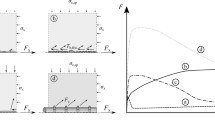Abstract
In the field of civil engineering, composite structures are in principle designed with a view to stable behaviour in the non-linear domain. Their design involves optimizing the choice of the materials used in these composite structures (the concrete and steel) and the choice of their spatial distribution (percentages and locations). A rigorous physical and mechanical analysis and clear definitions of what is meant by the ductility of the material and of the structure are necessary for the attainment of this objective. It is shown that such an approach leads in some cases to results at odds with the ideas generally accepted in the literature.
Similar content being viewed by others
References
Mandel, J., ‘Propriétés Mécaniques des Matériaux,’ Rhéologie-Plasticité Ouvrage publié avec le concours du CNRNS (Eyrolles, 1978).
Suquet, P., ‘Plasticité et Homogénéisation,’ thèse d'état, Université Pierre et Marie Curie (1982).
Hill, R., ‘Acceleration waves in solids mechanics,’J. Mech. Phys. Solids 10 (1982) 1–16.
Rice, J. R., ‘The localization of plastic deformation,’ in ‘Theoretical and Applied Mechanics,’ edited by W. T. Kaiter (North-Holland, 1976).
Hadamard, J., ‘Leçons sur la Propagation des Ondes et des Équations de l'Hydrodynamique’, (Paris, 1903).
Thomas, T. Y., ‘Plastic Flow and Fracture in Solids’ (Academic, New York, 1961).
Mandel, J., ‘Conditions de stabilité et postulat de Drucker,’ in ‘Rhéologie et Mécanique des Sols,’ Proceedings of IVTAM symposium, Grenoble, 1964, edited by Kravtchenko and Syries.
Rice, J. R. and Rundnicki, J. W., ‘A note on some features of the theory of localization of deformation,’Int. J. Solids 16 (1980) 597–605.
Rudnicki, J. W. and Rice, J. R., ‘Conditions for the localization of deformation in pressure sensitive dilatant material,’J. Mech. Phys. Solids 23 (1975) 371–394.
Darve, F., ‘An incrementally non linear constitutive law of the second order and its application to localization,’ in Proceedings of International Conference on Constitutive Laws for Engineering Materials, Tucson, 1983.
Desrues, J., ‘La localisation de la déformation dans les matériaux granulaires’, thèse d'état, USMG, Grenoble (1984).
Coussy, D., ‘Dynamique des milieux hétérogènes et fissurés,’ thèse d'état (1985).
Helland, S., Einstabland, T. and Hoff, A., ‘High Strength Concrete’ (Norwegian Concrete Society, Norsk Betongday, 1983).
Mazars, J., ‘Application de la mécanique de l'endommagement au comportement non lineaire et à la rupture du béton de structure,’ thèse d'état, Université Paris VI (1984).
‘Constitutive Laws for Engineering Materials. Theory and Application,’ Proceedings of the Second International Conference, Tucson, 1987.
Rossi, P., ‘Fissuration du béton: du matériau à la structure. Application de la mécanique linéaire de la rupture,’ thèse, ENPC (1986).
Rossi, P., Acker, P. and Francois, D., ‘Measurements of the fracture toughnessK ic of concrete,’ in Proceedings of 6th International Conference on Fracture (ICF6), New Delhi, 1984, pp. 2833–2839.
Rossi, P., Boulay, C., Acker, P. and Malier, Y., ‘Influence of the crack opening rate on the fracture toughness of plain concrete,’ in Proceedings of the Fall Meeting of the Material Research, Society, Boston, 1985, pp. 39–46.
Rossi, P., Coussy, O., Boulay, C., Acker, P. and Malier, Y., ‘Comparison between plain concrete toughness and steel fibre reinforced concrete toughness,’Cem. Concr. Res. 16 (1986) 303–313.
de Larrard, F., Boulay, C. and Rossi, P., ‘Fracture toughness of high-strength concrete,’ in Proceedings of Symposium on the Utilization of High-strength Concrete, Stavanger, 1987.
Paillère, A., Buil, M., Serrano, J. S. and de Larrard, F., ‘High performance concrete by optimization of the use of superplasticizers and steel fibres,’ in Proceedings of AIPC Congress, Versailles, Sept. 1987.
Rossi, P., Acker, P. and Boulay, C., ‘Observation et identification de la microfissuration,’ in ‘Origine et mécanisme de la microfissuration,’ AFREM Report. Contract MRT-MULT 83 71 280 (1985) Ch. VI.
Acker, P., Boulay, C. and Rossi, P., ‘On the importance of the initial stresses in concrete and of the resulting mechanical effects,’Cem. Concr. Res., in press.
de Larrard, F., ‘Formulation et propriétés des bétons à très hautes performances,’ thèse, ENPC (1987).
Vzumeri, S. M. and Basset R., ‘Behaviour of high strength concrete members,’ in Proceedings of Symposium on the Utilisation of High-strength Concrete, Stavanger, 1987.
Ahmad, S. H. and Shah, S. P., ‘High strength concrete. A review,’ in Proceedings of Symposium on the Utilization of High-strength Concrete, Stavanger, 1987.
Author information
Authors and Affiliations
Rights and permissions
About this article
Cite this article
Rossi, P. The fragility and ductility of composite engineering materials and structures: a few remarks. Materials and Structures 22, 28–34 (1989). https://doi.org/10.1007/BF02472692
Issue Date:
DOI: https://doi.org/10.1007/BF02472692




